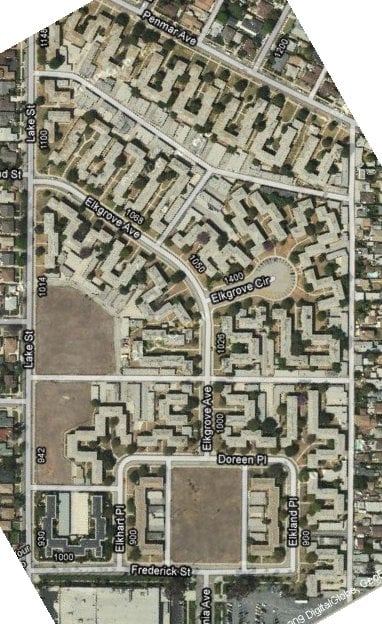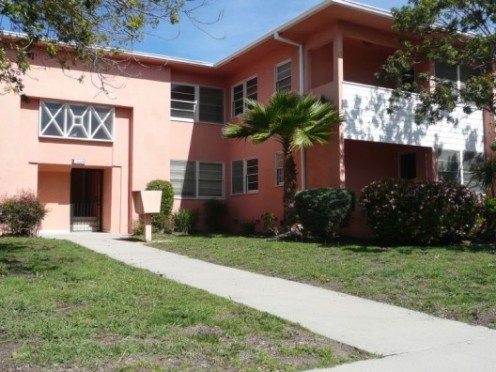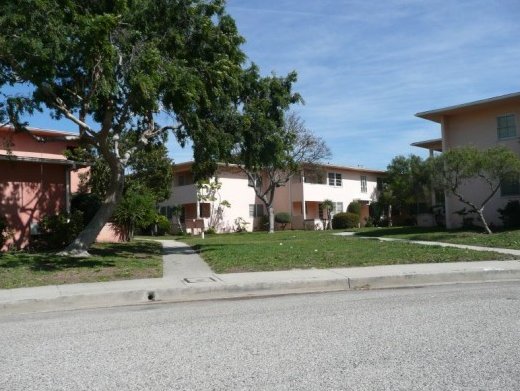Islands of Calm - Lincoln Place Los Angeles
Lincoln Place Beginnings
Lincoln Place was built between 1949 and 1951 in Venice California1. Consisting of fifty-two (52) apartment buildings it contained a total of seven hundred ninety-five (795) one and two bedroom units. The complex sits on almost forty (40) acres of prime real-estate on Los Angeles' Westside. Only forty-four of the original buildings remain after AIMCO bought the property with the intention of redeveloping it. In the process of redevelopment AIMCO altered one building and demolished seven others.
On August 4, 2005 the
California State Historical Resources Commission (CSHRC) in Sacramento deemed that the complex met all criteria for the California Register of Historical sites. CSHRC declared that the complex represented an "excellent enduring example of both the 'garden city2' property type
and of Modernist architecture." The commission also found that the complex was a major surviving example of post World War II moderate income housing.
In making the determination the Commissioners cited the unique site plan, as well as the livability of its spaces and the use of Modernist elements to make each building and its surrounding courtyards visually unique.
Lincoln Place was financed under Section 608 Title VI of the National Housing Act of 1934. As such it was the largest development financed under this act. The purpose of the act was to encourage development of low to middle income housing immediately after World War II.


Architecture
Architect: Heth Wharton (1892-1958), was the registered Los Angeles based architect responsible for the designs of Lincoln Place.
However, it was recently discovered that African-American architect Ralph Vaughn (1907-2000) led the design team on the project. Vaughn was also known as a designer working under Paul Williams on such buildings as the MCA building, Saks Fifth Avenue in Beverly Hills and some Hollywood residences. Vaughn's 1212 Westchester Place stands as testament to his architectural style. Vaughn's designs were featured in the magazine California Arts and Architecture. Vauhgn also worked as a set designer for MGM under Cedric Gibbons.
Lincoln Place Today
In 2001 AIMCO (Apartment Investment and Management Company) bought controlling interest in Lincoln Place from a 50% stake it had acquired earlier. It was AIMCO's stated intention to redevelop Lincoln Place into condominiums. However, AIMCO has never before sold property as single family homes and it's charter states that it is an apartment management company.
Regardless AIMCO made use of the Ellis Act, a law designed to allow business to redevelop land under some very stringent conditions3, to attempt to evict existing tenants. AIMCO succeeded in evicting fifty-nine (59) under questionable conditions before it was ordered to halt the process.
The complex now houses roughly eight (8) families. Liincoln Place has also been declared a historical land-mark.
As of now there is an impasse between AIMCO and the tenants with the future of the property in limbo.
If you choose to go by there and take a look at history do. Be aware however, that the property is guarded with regular patrols from a private security firm. Presumably this is to prevent homeless from squatting in vacant units.
Lincoln Place can be found by heading northeast on Lincoln Boulevard to California Street. Take a right onto California Street and look for Fredrick Street. Lincoln Place can be viewed from Fredrick Street, Elkland Place, Lake Street, Doreen Place, and Elkgrove Avenue.
The intersection of Lincoln and California is in Venice south of Santa Monica and north of Del Rey.
Lincoln Place Future
The future of this complex is in serious doubt. Though the court system has, so far, upheld the right of the remaining tenants to live there most tenants that were there before the court decision were evicted. Also, because of the attempt to use the Ellis Act to it's advantage and the city attorney's unwillingness to sue AIMCO for violating the original agreement4 the future of this place remains in doubt.
No further rentals are taking place on the property; no new leases have been signed nor have any new tenants been accepted. This one fact seems to indicate, to me at least, that the company may be willing to sit on the property until the last tenant dies (of natural causes of course) or simply gives up and moves away.
No matter what this prime location is sure to be far more valuable than the meager income from eight rentals.



Island of Calm
I strongly suggest that if you are in Southern California on the westside that you take a few minutes out of your day to visit this place before it truly becomes history.
There are very few buildings of this type left in existence and I'm somewhat certain that AIMCO will eventually get it's way (legally or otherwise) and Lincoln Place will cease to exist.
Footnotes
1 Venice is actually a suburb of Los Angeles; not a city unto itself.
2By design, the city-garden concept means wide open spaces with a lower number of apartment units per square acre than modern apartment block layouts. The concept was an attempt to provide multi-family housing in garden like open settings featuring shared courtyards. This would encourage interaction among tenants and hopefully strengthen the sense of community.
3The Ellis Act states that property can only be
redeveloped from an apartment complex if all tenets are evicted prior
to the property being redeveloped into commercial or single-family home
housing. The act does not allow for redevelopment from existing apartments to new apartments. The act also states that existing tenants must be compensated
a minimum of $4,945 with amounts not exceeding $14,836. The act also
states that an additional $3,296 must be paid to senior or disabled
tenants. Further, the Ellis Act states that any units re-rented must be
rented for the exact amount of the previous rent with evicted persons
getting first choice on rental units. The purpose of the act is to
protect both tenants and landowners financially.
The Ellis Act is intended to prevent landlords from emptying units only to re-rent them at substantially higher rates. The Act does not always prevent this though since court hearings and the city attorney's office must become involved to prevent abuses.
4AIMCO agreed to redevelop on the condition that none of the existing tenants would be moved off of the property against their will. This was BEFORE an attempt on AIMCOs part to invoke the Ellis Act. This short time-line of events sparked the legal battles that have been ongoing for the last fifteen years.








